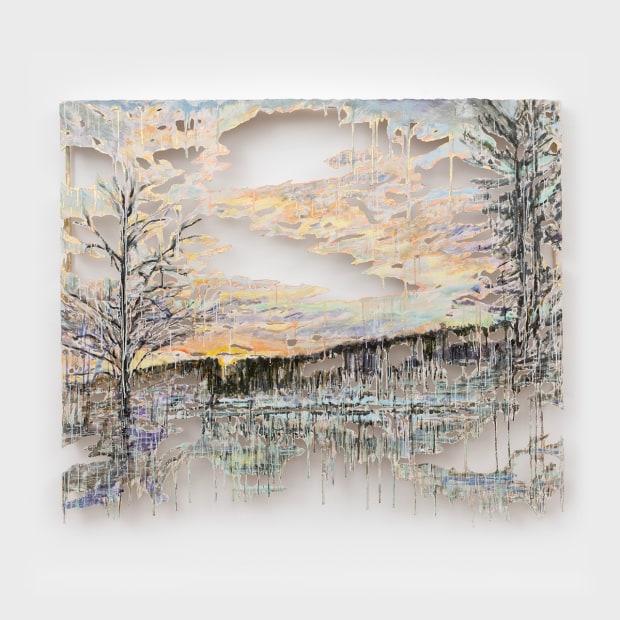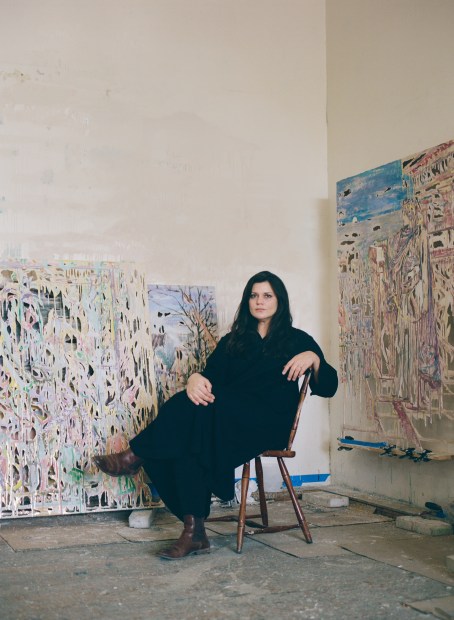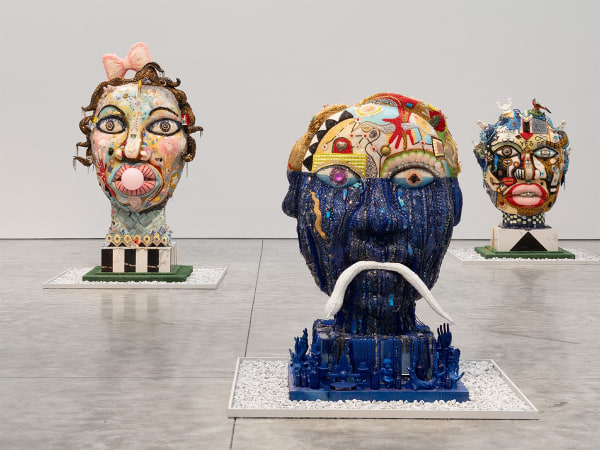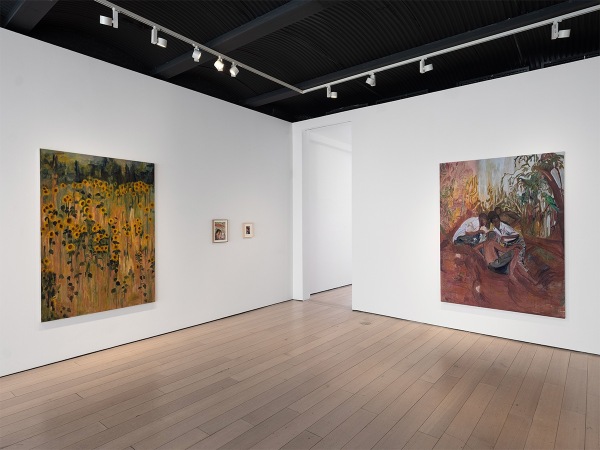-
-
Booth D6 | February 20–23, 2025
Santa Monica Airport
3027 Airport Avenue, Santa Monica, CA 90405Kasmin returns to Frieze Los Angeles in February 2025 with a solo presentation of new wall panels and a sculpture by Diana Al-Hadid (b. 1981). In the series of panels, Al-Hadid explores the interplay of sky and landscape as a compositional foundation for her richly allegorical work. Known for her alchemical approach to material, Al-Hadid employs a controlled dripping technique, interlacing mass and void through complex layers of polymer gypsum, fiberglass, pigments, and metal leaf. By engaging with architectural forms—referencing ruins, historical structures, and sacred spaces—the work considers the impermanence of civilization and the ambiguous presence of the human figure. As they invoke ghostly apparitions of art historical characters and landscapes, Al-Hadid’s abstracted sculptural narratives allude to themes of memory, empire, and migration.
Frieze marks the first Los Angeles solo presentation in ten years for Al-Hadid, whose first of numerous solo museum exhibitions was held at the Hammer Museum at UCLA in 2010, and anticipates Diana Al-Hadid: unbecoming, a two-decade survey of Al-Hadid’s work at the MSU Broad Art Museum in East Lansing, MI, in June 2025. Also in 2025, Al-Hadid will unveil a major site-specific sculpture at Princeton University Art Museum’s new building
-

-

-
-

-

-
-

-

-

-
Al-Hadid revisits the theme of the jasmine plant, the national flower of Syria, in a unique bronze sculpture also on view. Expanding her recent engagement with the natural world, the artist has cast a set of roots pulled from her recent commission at Cleveland’s Syrian Cultural Garden for FRONT International: Cleveland Triennial for Contemporary Art in 2022 to create Warda II (2024-25). She has described her Warda sculptures as a metaphor for the immigrant experience: when root-bound plants grow, their roots push to the edges of their pots before learning to adapt to new soil. Warda II offers an emblem of human resilience in the face of adversity, highlighting the natural ability to find stability in new terrain.
Frieze Los Angeles looks forward to the opening of Al-Hadid’s survey exhibition at the MSU Broad Art Museum in East Lansing, MI, from June 7 through December 21, 2025. Diana Al-Hadid: unbecoming will question how constructions of femininity take form over time through nearly two decades of paintings, sculptures, and works of handmade paper realized especially for the exhibition. It will position the artist’s reworking of materials and form as a process that models how we can similarly transform the social expectations about womanhood and women’s behavior to instead find the power in being “unbecoming.”
In late 2025, Al-Hadid will unveil a site-specific sculpture on the grounds of the Princeton University Art Museum’s new building. Inspired by her research in the museum’s collection of ancient art, including works from near her birthplace of Aleppo, Al-Hadid will create a monumental work that The New York Times has described as “a ghostly ziggurat in aluminum.” Al-Hadid has said of the work, “I am interested in the suggestion that this ancient structure might lay stored—in some ways buried—within a very contemporary new building.”
-
-
About the Artist
 Portrait by Charlie Rubin.
Portrait by Charlie Rubin. -
Join our Newsletter
* denotes required fields
We will process the personal data you have supplied in accordance with our privacy policy (available on request). You can unsubscribe or change your preferences at any time by clicking the link in our emails.
-
Explore
-

vanessa german: GUMBALL—there is absolutely no space between body and soul
April 3 – May 10, 2025 509 West 27th Street, New York, 514 West 28th Street, New YorkKasmin presents its second solo exhibition of new work by artist vanessa german, which debuts related bodies of sculpture across two of the gallery’s spaces in New York. The exhibition deepens german’s singular approach to sculpture as a spiritual practice with the power to transform lived experience. Both series comprise mineral crystals, beads, porcelain, wood, paint and the energy that these objects bring to life to form monumental heads and figures in the act of falling. Together, each body of work envisions the transformation of consciousness necessary to imagine a new world. -

Helena Foster: Time Honoured
April 3 – May 3, 2025 297 Tenth Avenue, New YorkThe first New York solo exhibition of London-based painter Helena Foster features new oil paintings on linen, paper, and vellum that express the artist’s lyrical approach to painting as an accumulation of cultural and generational wisdom. Foster draws freely from literature, theater, film, Igbo oral tradition, and religion, achieving a dreamlike aura of mystery in dynamic compositions ambiguously set between thick vegetation and the built environment.
-
-
Explore
- Diana Al-Hadid
- Alma Allen
- Theodora Allen
- Sara Anstis
- Ali Banisadr
- Tina Barney
- Judith Bernstein
- JB Blunk
- Mattia Bonetti
- William N. Copley
- Cynthia Daignault
- Ian Davenport
- Max Ernst
- Liam Everett
- Leonor Fini
- Barry Flanagan
- Walton Ford
- Jane Freilicher
- vanessa german
- Daniel Gordon
- Alexander Harrison
- Elliott Hundley
- Robert Indiana
- Lee Krasner
- Les Lalanne
- Matvey Levenstein
- Lyn Liu
- Robert Motherwell
- Jamie Nares
- Nengi Omuku
- Robert Polidori
- Jackson Pollock
- Elliott Puckette
- Alexis Ralaivao
- George Rickey
- James Rosenquist
- Mark Ryden
- Jan-Ole Schiemann
- Joel Shapiro
- Bosco Sodi
- Dorothea Tanning
- Naama Tsabar
- Bernar Venet
Diana Al-Hadid at Frieze Los Angeles
Santa Monica Airport, Los Angeles, February 20 – 23, 2025
Kasmin Sculpture Garden
New York
On view from The High Line at 27th Street
Monday–Sunday, 7am-11pm
+1 212 563 4474
info@kasmingallery.com
Facebook, opens in a new tab.
Twitter, opens in a new tab.
Instagram, opens in a new tab.
Join the mailing list
Send an email
© 2025 Kasmin Gallery
This website uses cookies
This site uses cookies to help make it more useful to you. Please contact us to find out more about our Cookie Policy.












